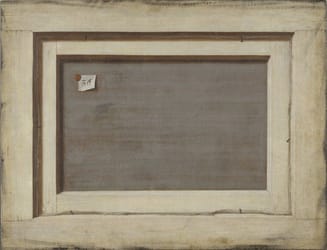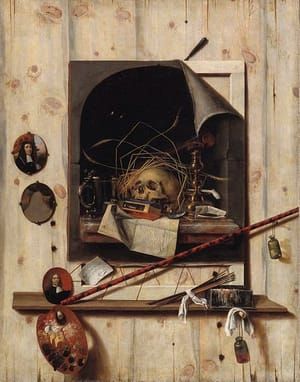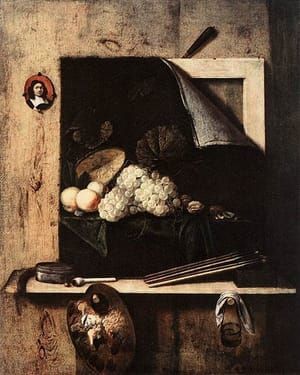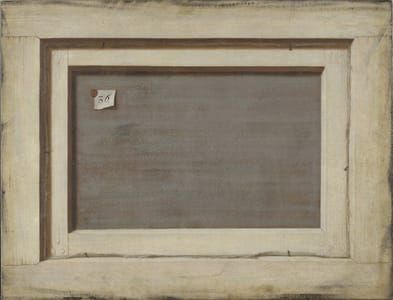![With the absence of the frame that traditionally serves as the architectural transition between the spectator’s reality and the picture’s painted universe, this work by the Flemish painter Gijsbrechts is moving beyond the usual realms of art and into the illusionistic domains of the stage.
The deception of the eye is certainly there. When viewing the picture from afar, we are truly cheated into believing that the artist has left a painting behind on the floor with its reverse facing outwards. With its ability to surprise and deceive the spectators, this work was eminently qualified to be part of the royal Kunstkammer.
[http://www.smk.dk/en/explore-the-art/highlights/cornelius-norbertus-gijsbrechts-trompe-loeil-the-reverse-of-a-framed-painting/]
...What was Gijsbrecht's intention with the painting, other than displaying his virtuosity? Jaap Goudsmit convincingly argues that Gijsbrecht teaches us that death becomes ever more predominant with advancing years. The imagined front of the painting depicts the journey of discovery of the life and the time we spend in the awareness of our mortality - vanitas, a favorite subject of Gijsbrecht's; the back depicts the inevitable end. In '"The Art of Facing Mortality" Goudsmit discusses, from the perspective of the scientist and drawing from literature, highlights of Western art that tells us about life and death.
[https://www.bol.com/nl/p/the-art-of-facing-mortality/9200000064160332/]
...Like any practical joke, trompe l'oeil is a two-stage game. The first stage is illusion, when you're taken in. The second stage is realization, when you're appreciating how it's done. But there is one ultimate trick. What better, what more obvious subject for a trompe l'oeil picture than a picture itself? You thought you were looking at a picture. But no, you are mistaken. It's only a picture of a picture. The painting by Cornelius Gijsbrechts called The Reverse Side of a Painting is exactly that.
On a medium-sized canvas, the artist has painted the likeness of a framed painting, seen from behind. It's a nest of rectangles. On the outside, there's the woodwork of the picture's frame. Inside that, there's another wooden oblong, the stretcher, to which the canvas is attached. And within that, a darker grey-brown, the bare back of the canvas shows. With each layer we go a step down, a step deeper.
Light is imagined to fall from top left. It casts L-shaped shadows across the receding ridges, bringing them up into solid three-dimensionality. But the space is still shallow, and this trompe l'oeil takes full advantage of the basic flatness of its subject. The flat back of the fictional canvas equates to the flat surface of the real canvas. What's more, the subject is itself rectangular, its edges coinciding exactly with the painting's edges.
Then the illusion takes off. Everywhere, the artist has carefully contrived those little accidental touches that make for authenticity. Realism is often a matter of noting the tiny irregularities and attritions of the world. (Not too many, though - that will look start to look studied.) So note the warps and cracks in the wood grain. Note the small pins holding the rectangles together, bent in at various angles. Gijsbrechts is expert in the textures of contingency.
If you're at the illusion stage, these things will contribute to your illusion. You will register them out of the corner of your eye, as the way things go. But if you're at the realisation stage, you will marvel at them. How well the artist has noticed the inconspicuous tics of the world - things we normally just take as read.
And look at those smears of black paint rubbed around the edges of the frame. It's not just random mess. It's a contingency, observed. Gijsbrechts has noticed how, when the sides of a frame are being painted, the brush will often casually smudge some of the paint round on to the back. It doesn't matter. No one will see.
One of the pleasures of this painting is in seeing what normally isn't seen. You're glimpsing a painting naked, its back parts. You're seeing a picture, not as a beguiling image, but as a physical object, a bundle of raw materials, a commodity for sale.
For there is that last detail: the little square tab of paper, fixed with red sealing wax, bearing the number 36. Again, it has a touch of show-off accidentality. See how the corner of the tab has folded over. But it also has its story. This is the sale-room ticket.
Quite likely, The Reverse Side of a Painting would have first been exhibited in a sale-room. Propped casually against the wall, it would await the unwary. And then a customer would approach, take an interest in the hidden painting, pick it up and turn it round. What a moment of cognitive dissonance.
It is a perfect and triumphant vindication of the power of art to deceive.
(http://www.independent.co.uk/arts-entertainment/art/great-works/gijsbrechts-cornelius-the-reverse-side-of-a-painting-1670-744408.html)](/img/jpg/large/000017344e1f9f069.jpg)

Trompe l'oeil. The Reverse of a Framed Painting, 1670
Cornelis Norbertus Gijsbrechts
With the absence of the frame that traditionally serves as the architectural transition between the spectator’s reality and the picture’s painted universe, this work by the Flemish painter Gijsbrechts is moving beyond the usual realms of art and into the illusionistic domains of the stage.
The deception of the eye is certainly there. When viewing the picture from afar, we are truly cheated into believing that the artist has left a painting behind on the floor with its reverse facing outwards. With its ability to surprise and deceive the spectators, this work was eminently qualified to be part of the royal Kunstkammer.
[http://www.smk.dk/en/explore-the-art/highlights/cornelius-norbertus-gijsbrechts-trompe-loeil-the-reverse-of-a-framed-painting/]
...What was Gijsbrecht's intention with the painting, other than displaying his virtuosity? Jaap Goudsmit convincingly argues that Gijsbrecht teaches us that death becomes ever more predominant with advancing years. The imagined front of the painting depicts the journey of discovery of the life and the time we spend in the awareness of our mortality - vanitas, a favorite subject of Gijsbrecht's; the back depicts the inevitable end. In '"The Art of Facing Mortality" Goudsmit discusses, from the perspective of the scientist and drawing from literature, highlights of Western art that tells us about life and death.
[https://www.bol.com/nl/p/the-art-of-facing-mortality/9200000064160332/]
...Like any practical joke, trompe l'oeil is a two-stage game. The first stage is illusion, when you're taken in. The second stage is realization, when you're appreciating how it's done. But there is one ultimate trick. What better, what more obvious subject for a trompe l'oeil picture than a picture itself? You thought you were looking at a picture. But no, you are mistaken. It's only a picture of a picture. The painting by Cornelius Gijsbrechts called The Reverse Side of a Painting is exactly that.
On a medium-sized canvas, the artist has painted the likeness of a framed painting, seen from behind. It's a nest of rectangles. On the outside, there's the woodwork of the picture's frame. Inside that, there's another wooden oblong, the stretcher, to which the canvas is attached. And within that, a darker grey-brown, the bare back of the canvas shows. With each layer we go a step down, a step deeper.
Light is imagined to fall from top left. It casts L-shaped shadows across the receding ridges, bringing them up into solid three-dimensionality. But the space is still shallow, and this trompe l'oeil takes full advantage of the basic flatness of its subject. The flat back of the fictional canvas equates to the flat surface of the real canvas. What's more, the subject is itself rectangular, its edges coinciding exactly with the painting's edges.
Then the illusion takes off. Everywhere, the artist has carefully contrived those little accidental touches that make for authenticity. Realism is often a matter of noting the tiny irregularities and attritions of the world. (Not too many, though - that will look start to look studied.) So note the warps and cracks in the wood grain. Note the small pins holding the rectangles together, bent in at various angles. Gijsbrechts is expert in the textures of contingency.
If you're at the illusion stage, these things will contribute to your illusion. You will register them out of the corner of your eye, as the way things go. But if you're at the realisation stage, you will marvel at them. How well the artist has noticed the inconspicuous tics of the world - things we normally just take as read.
And look at those smears of black paint rubbed around the edges of the frame. It's not just random mess. It's a contingency, observed. Gijsbrechts has noticed how, when the sides of a frame are being painted, the brush will often casually smudge some of the paint round on to the back. It doesn't matter. No one will see.
One of the pleasures of this painting is in seeing what normally isn't seen. You're glimpsing a painting naked, its back parts. You're seeing a picture, not as a beguiling image, but as a physical object, a bundle of raw materials, a commodity for sale.
For there is that last detail: the little square tab of paper, fixed with red sealing wax, bearing the number 36. Again, it has a touch of show-off accidentality. See how the corner of the tab has folded over. But it also has its story. This is the sale-room ticket.
Quite likely, The Reverse Side of a Painting would have first been exhibited in a sale-room. Propped casually against the wall, it would await the unwary. And then a customer would approach, take an interest in the hidden painting, pick it up and turn it round. What a moment of cognitive dissonance.
It is a perfect and triumphant vindication of the power of art to deceive.
(http://www.independent.co.uk/arts-entertainment/art/great-works/gijsbrechts-cornelius-the-reverse-side-of-a-painting-1670-744408.html)
26 x 34 in
Uploaded on Dec 19, 2017 by Suzan Hamer
Cornelis Norbertus Gijsbrechts
artworksArthur
Wait what?


